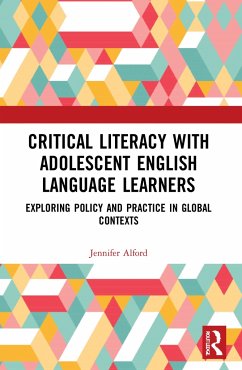This book examines critical literacy within language and literacy learning, with a particular focus on English as an Additional Language learners in schools who traditionally are not given the same exposure to critical literacy as native-English speakers. An important and innovative addition to extant literature, this book explains how English language teachers understand critical literacy and enact it in classrooms with adolescent English language learners from highly diverse language backgrounds.
This book brings together the study of two intersecting phenomena: how critical literacy is constructed in English language education policy for adolescent English language learners internationally and how critical literacy is understood and enacted by teachers amid the so-called 'literacy crisis' in neoliberal eduscapes. The work traces the ways critical literacy has been represented in English language education policy for adolescents in five contexts: Australia,England, Sweden, Canada and the United States. Drawing on case study research, it provides a comparative analysis of how policy in these countries constructs critical literacy, and how this then positions critical engagement as a focus for teachers of English language learners.
Empirically based and accessibly written, this timely book will be of interest to a wide range of academics in the fields of adolescent literacy education, English language learning and teaching, education policy analysis, and critical discourse studies. It will also appeal to teachers, post-graduate students and language education policy makers.
This book brings together the study of two intersecting phenomena: how critical literacy is constructed in English language education policy for adolescent English language learners internationally and how critical literacy is understood and enacted by teachers amid the so-called 'literacy crisis' in neoliberal eduscapes. The work traces the ways critical literacy has been represented in English language education policy for adolescents in five contexts: Australia,England, Sweden, Canada and the United States. Drawing on case study research, it provides a comparative analysis of how policy in these countries constructs critical literacy, and how this then positions critical engagement as a focus for teachers of English language learners.
Empirically based and accessibly written, this timely book will be of interest to a wide range of academics in the fields of adolescent literacy education, English language learning and teaching, education policy analysis, and critical discourse studies. It will also appeal to teachers, post-graduate students and language education policy makers.
"Current conversations and debates around the culture wars, cancel culture, critical race theory and critical literacy make Jennifer Alford's comprehensive text highly relevant to these times..." [...] "Alford's considered appraisal of critical literacy and her inclusive analysis of so many of the complex issues surrounding the teaching of critical literacy with EAL students is commendable. She delves into teachers' inherent beliefs, their acquired understandings, what value EAL students bring to the learning, the tensions existing between shifting policy directions and teachers' practices and around the many and varied texts students engage with and are exposed to with respect to access, domination, diversity and design..." [...] "It is a text worthy of all educators' reading and returning to in our challenging post-truth world in order to empower teachers and students with agency to understand how they are being shaped and with their ability to enact social change."
Gloria Latham is currently the co-editor of Literacy Learning: the Middle Years.
Gloria Latham is currently the co-editor of Literacy Learning: the Middle Years.

